KTM’S 2024 ENDURO MODELS: ENGINE MODS EXPLAINED
KTM’s head of off-road engine development, Florian Bretterebner, offers a fascinating insight into the key engine updates introduced to KTM’s landmark 2024 enduro models – both two-strokes and four-strokes.
In the wake of this year’s international media launches for the 2024 enduro models from KTM and Husqvarna, there was lots of talk about the fact these bikes came with 95% new parts – including a radically different ‘stiff frame concept’ and WP’s all-new XACT closed-cartridge fork. And that’s thoroughly understandable because the new-generation chassis and suspension ensure these 2024 models are arguably both brands’ most radically updated enduro machines ever.
But amid all that rolling chassis fanfare, some of the very significant updates to both the two- and four-stroke engines got overlooked. So, to help shine a spotlight on the 2024 range’s key engine mods, we sat down for an enlightening chat with Florian Bretterebner – the likeable dude who heads up the design team behind KTM’s off-road model powerpack development…
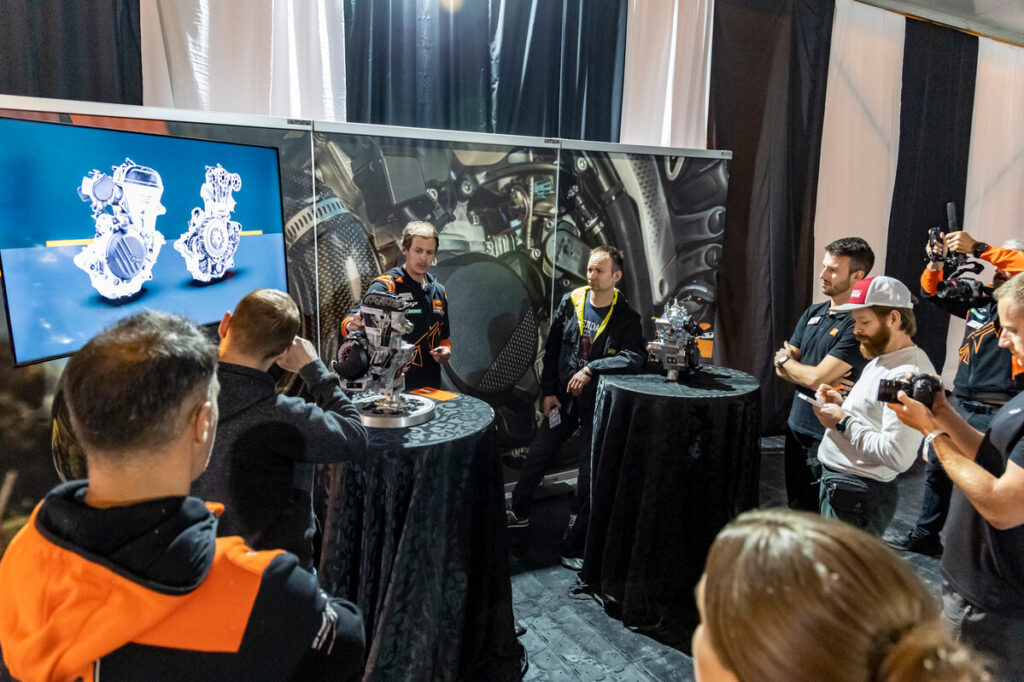
TM: Florian, can we start with your official job title … because it’s a convoluted one, right?
SW: Yes [laughs]. Officially, I am Head of Powerpack Off-Road ICE – which stands for Internal Combustion Engines – in KTM’s R&D Department in Mattighofen.
And you’ve been at KTM for about a decade now, working with engine development royalty such as Michael Viertlmayr.
I’ve actually been with KTM for 11 years now. And, yes, Michael Viertlmayr is my boss. He is now Vice President for all KTM engines – Street and Off-Road – and I took over his role as Head of Off-Road.
Give us an idea of how your off-road engine team is structured.
Well, my team is shared across motocross and off-road models, and it’s split into six teams: Mini, 50-85cc two-stroke, 125-150cc two-stroke, 250-300cc two-stroke, 250-350cc four-stroke and 450-500cc four-stroke. Everybody on those teams is totally into riding. They are all very focused and they put so much effort in to developing their engines. Plus, each team has dedicated test riders. And so, it has been really gratifying for us to hear all the positive feedback from independent journalists after this year’s international media launch for the 2024 models.
Understandably, the all-new XACT CC fork and frame stole the limelight with KTM’s 2024 enduro models. But it feels to me that the significance of a few of the of the bikes’ engine mods were a little overlooked?
I agree because there have been so many mods across both two-stroke and four-strokes engines for 2024. And I don’t just mean the move from the TPI (Transfer Port Injection) to TBI (Throttle Body Injection) fuel-injection system for the two-strokes. The work it took to update the four-strokes’ engine cases alone is massive and required a huge amount of design effort and engineering skill. Then there’s all the updates that are hidden from view – such as how the transmission is lubricated and how the clutch is lubricated. For example, on the 450cc engine, the lubrication of the clutch used to be via sucking the oil out of the crankcases, whereas it’s now a pressurised system – like we already use on the 250 and 350 four-stroke engines – which is way more efficient. That is just one example of countless small but very significant details we’ve improved for 2024.
Coming back to the engine mounts; that’s a drastic change because the engine cases’ mounting points for all four four-stroke engines needed to be relocated so they all lined up with the identical frame now used across the 2024 250, 350, 450, 500EXC-F models. Talk about the chassis guys making the engine team’s life difficult, eh?!
Well, yes [laughs]. It was a big and very complex job. But we didn’t see that design requirement as difficult because we are all on the same team, and we all realised the longer-term benefits of making this change. Then it was simply a matter of finding the best solution – which was more difficult for some capacities’ engine cases than others.
Speaking of component ‘standardisation’, there are now only two different transmissions across the entire enduro range – one for the 150EXC, and one for the other six models – albeit with different primary and secondary gearing, right?
That’s right. Also, the shifting mechanism is now the same from the 250EXC right up to the 500EXC-F. This standardisation was not about cost savings, but to improve performance. Compared with the 350’s transmission, the distance between the input shaft and output shaft on the 450 and 500 were larger, but the gear-wheels themselves were thinner – which was not the toughest or most compact design. That’s why we adopted the 350’s existing transmission design to the other three four-stroke models for 2024, and then fine-tuned each of them with their own primary and secondary gearing.
Speaking of gearing, I understand the gear used for the oil pump has changed from plastic to a sintered material for 2024.
Exactly. The oil pump gear used to be made from a slightly lighter reinforced plastic, but the sintered steel gear now used is much more robust. This is just one of many examples of mods we made. There were so many, they couldn’t all be captured by the update information about these new bikes.
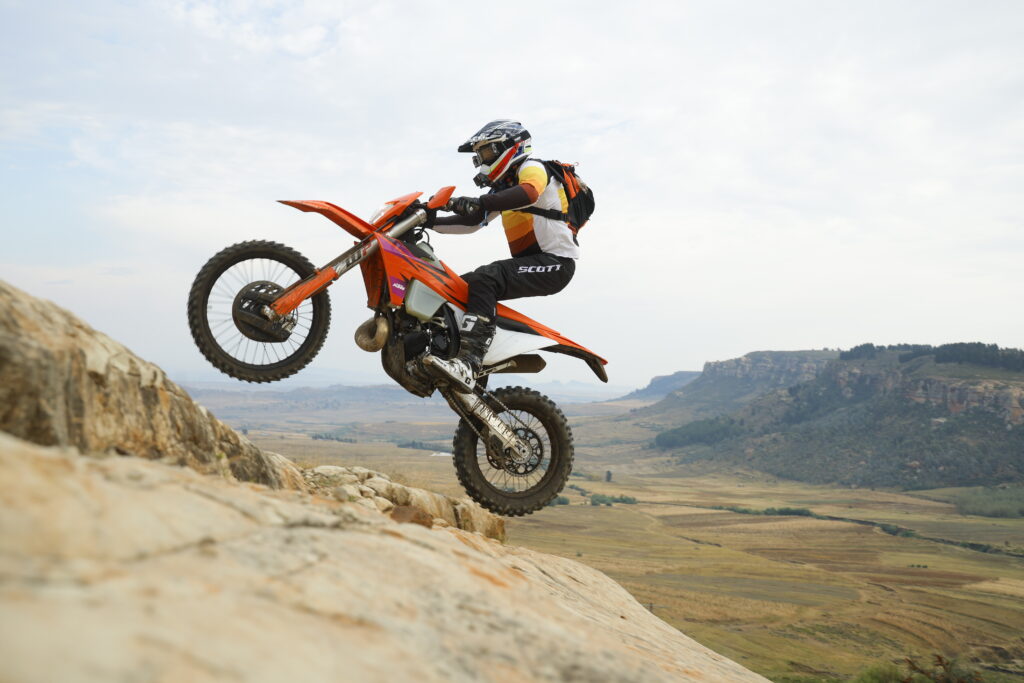
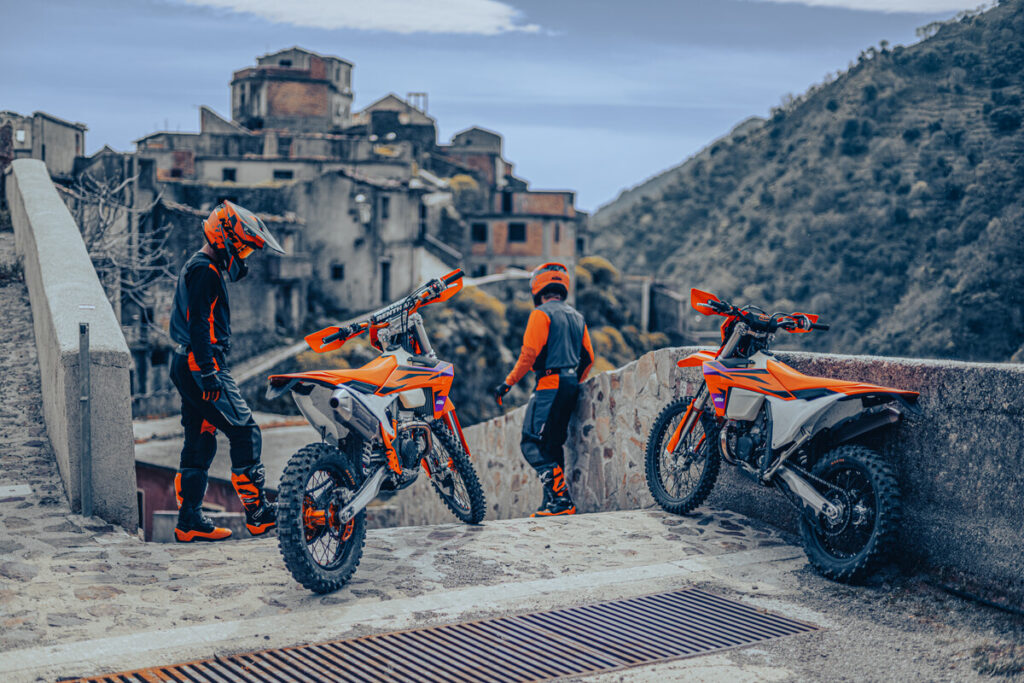

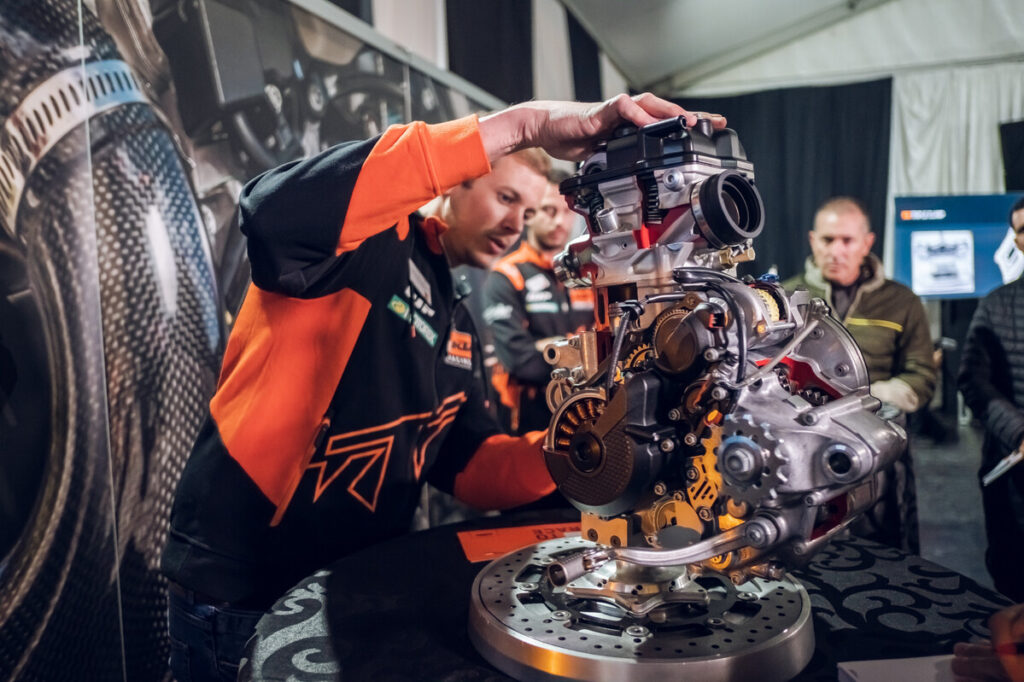
Okay, let’s talk about the introduction of the two-stroke Throttle Body Injection (TBI), which – combined with the new electronic power-valve – is arguably the most significant engine mod to the 2024 range. How did you guys manage to adapt the TBI system to these bikes and still comply with Euro5 emission regs? Because, up till recently, only the TPI system would comply.
Well, we developed both the TPI and TBI systems simultaneously. In 2018, we released the first two-stroke enduro models with the TPI mainly because that system was better when it came to emission levels. But of course, we continued to study and develop the TBI system with many simulations to better understand how it worked. And through that process, we were able to get the emission homologation for the TBI system.
But introducing TBI is not just about emissions; it’s also allowed performance gains, right?
Absolutely. And that is why we worked so hard to get it homologated.
Explain how the TBI’s dual injection works. I understand there’s now an injector either side of the throttle body’s butterfly.
That’s correct. The injector on the engine side operates all the time. Then the second injector starts to operate at larger throttle openings and higher engine speeds when you need more fuel mass. You can see that, when the butterfly flap is open, both injectors spray from the bottom of the throttle body to create a more homogeneous air/fuel mixture. And when you have this more consistently mixed fuel and air enter the combustion chamber, it makes it much easier to find performance gains – though it is still critical to have an efficient transfer port design to ensure the TBI works optimally.
And that was the issue with the TPI system, right? With a less homogeneous air/fuel mixture, the TPI bikes’ RPMs would ‘hunt’ up and down when you held them at a constant throttle setting.
Yes, that’s right. And the more homogeneous air/fuel mixture with the TBI system also gives you a more instantaneous response to throttle inputs.
In layman’s terms, why is the mixture more homogeneous – or consistent – with the TBI system?
It’s complex, but in simple terms, it’s because the air and fuel are mixing ‘earlier’; they are mixing in the throttle body rather than in the cylinder’s transfer ports themselves. With the TPI system, where the injectors were spraying the fuel against the direction of the airflow, the mixing was still pretty good. But with the TBI system, you have a longer distance for the mixing process to take place before that mixture is combusted. And at higher revs, a consistent mixture becomes very important.
Is it fair to say that this TBI system is only as good as its partner in crime, the all-new electronic power-value?
Yes, that is fair to say. KTM is not the first to introduce an electronic power-valve, but I believe our electronic power-valve is a clever design and works very effectively. It involves a step-motion motor that activates a shaft which runs from the left- to right-hand side to open and close the auxiliary ports perfectly and with very small tolerances. As two-strokes are super-sensitive to thermo-dynamics and the timing of their port opening, this design was critical to optimising performance. On the shaft, some metal-injected moulding parts are mounted, which feature cams. And those cams actuate the main exhaust flap. Then there is a secondary gear on the cam that activates the auxiliary exhaust ports.
The power-valve system on the previous models also used a cam for exhaust ports, so how is this one different?
Yes, the predecessor models did use a cam design with really steep cam lobes. But this new electronic power-valve design is way more bulletproof, plus it can’t get stuck.
Explain what the new “KTC” (KTM Torque Chamber) is and what it does.
Well, it’s not new. It was actually used on the 380EXC two-stroke many years ago but has been reintroduced for 2024 on the 250 and 300EXC models. And it’s something I’m very excited about because I think it plays a major role in the engines’ performance gains. Effectively, it gives you like a two-header design because with enduro bikes, you normally go with a bigger header and more resonance volume to generate more torque down low – as opposed to a more peak power-oriented motocross bikes, which use a smaller pipe. With the KTC system on our 2024 enduro models, you effectively get both benefits. You don’t lose peak power because, as I explained, you close it with the exhaust flap. But you still retain the power at lower revs, which is where I think the biggest improvement is achieved.
Yet another step closer to a four-stroke style of power, eh? Plus, the two-stokes now feel so refined, they actually vibrate less than the four-strokes!
Absolutely. They now have so much torque at low revs, and they’re very responsive from low RPMs too. That means a wider operating window and better rideability.

Speaking about comparing two- and four-strokes, how come the clutch-pull on the two-strokes feels noticeably lighter?
The stiffest diaphragm spring is used on the 500EXC-F clutch because it has the most torque and is the only model to use the same spring as the 450SX-F motocross bike. Meanwhile, the other capacities each come with a lighter variation of that diaphragm spring. Also, the two-strokes have different friction plates in their clutches, which may contribute to that slightly lighter feel.
What happened to the two-stroke models’ ribbed expansion chamber design? When these pipes were introduced back in 2017, KTM had told us they were an unequivocal win-win; that they were stronger than a conventional expansion chambers and they managed to help muffle noise emissions.
That continues to be true. But, with the change from the centrifugal to electronic power-valve for the 2024 models, the additional space created allowed us to route the expansion chambers in a more compact way – that is, closer to the engine and frame and with more ground clearance – and still find performance gains. Also, removing the ribs eliminated customer complaints about the added costs associated with removing dents from their pipe. Removing the ribs also helped us with homologation for the 2024 models, but that’s not to say the ribs won’t find their way back onto our two-strokes at some time in the future, if you know what I’m saying [laughs].
I couldn’t help but notice that you rode several of the 2024 bikes at the international media launch yourself. So, what’s your favourite and why?
On the four-strokes, it’s a toss-up for me between the 350 and 450. If I rode mainly enduro, I would choose the 350 because it does everything so well in a variety of different terrain. But if I rode a combination of enduro and motocross, I’d go for the 450. On the two-stroke side, my favourite is the 300 – especially in slippery conditions. But I must say that I felt really comfortable on the 150 as well. Once I adapted my riding style, I just loved how lightweight and nimble it felt. It was almost like a mountain bike to throw around, but it also puts out an incredible amount of useable power for a small-capacity machine.
As with KTM’s 2023 MX models, there was lot of talk about serviceability for the 2024 enduro models. What stands out for you as examples of this improved serviceability?
I think the new markings in the engine cases are very handy. There’s a casting mark for oil level, and the same goes for coolant. It sounds so simple, but when you do maintenance on your bike, it saves you from having to look up the owners manual to figure out where fluid levels need to be. Similarly, there’s a triangle mark on the cases to remind owners which bolts require copper washers, plus recommended torque settings indicated for many bolts – or the most important ones, anyway. All very simple, but all very convenient for owners. Then there are things like, on the 450, we introduced a plug in the ignition cover so you can easily spin the engine to TDC and insert the crank bolt to keep it there.
Thanks for your time, Florian. And congratulations to you and your team on the smorgasbord of new and improved powerplants for 2024.
You’re welcome, Andy. It’s been great to have you media guys test the bikes at the launch and give us your feedback.
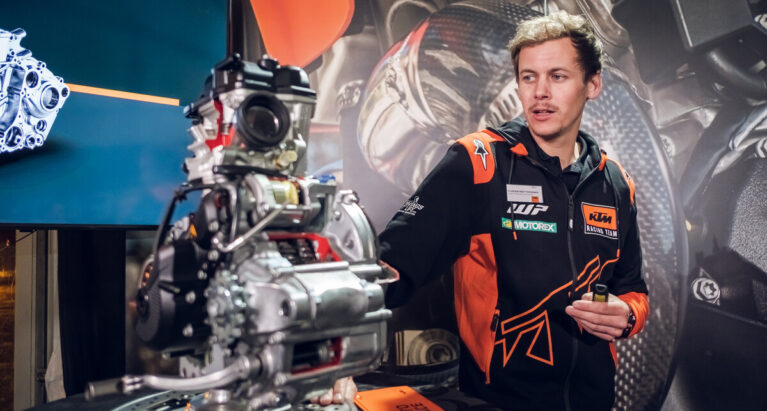



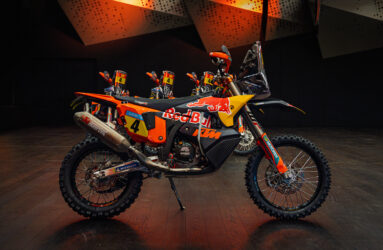
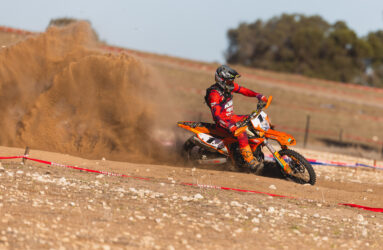
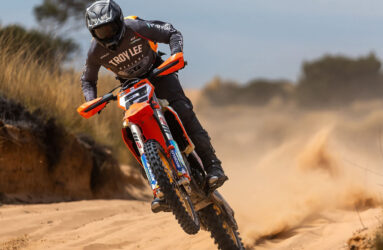


Be the first to comment...